 |
 |
 |
| |
|
|
|
|
|
THE
SECRET HISTORY OF
MERMAIDS
By William Bond
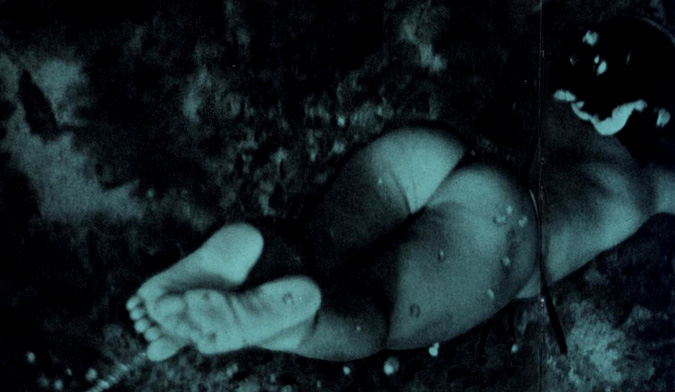
PREVIEW FROM WILLIAM BOND'S NEW BOOK
The official explanation of the mermaid myth goes like this: Sailors see manatees, walruses or seals, and mistake them for women with a fish’s tail. Which suggests these sailors were either drunk, idiots or very ignorant. It is claimed that even famous explorers like Christopher Columbus and Henry Hudson have made this error because they also reported seeing these creatures. As did John Smith, who became the Governor of the Virginia Colony in the early 17th century. So are we to believe that even Columbus, Hudson and Smith were so stupid as to mistake a sea cow or walrus for a mermaid? These men were experienced sailors and very well acquainted with marine life in the ocean. Either they were half-bind and credulous, or is there some other explanation for the mermaid myth?
To explain the apparent confusion some people have pointed out that the vagina of female sea-cows is very similar to that of a human female. So it could be that sailors may have had sex with manatees, and to cover up this act of bestiality they claimed they had intercourse with a mermaid. The problem is that there are thousands of stories about shepherds who have sex with sheep and they certainly don’t invent a mythical creature to hide this act. They simply keep quiet about it. Another explanation supposes that sailors on long sea voyages without the company of women, become so sex-starved that anything remotely resembling a woman in the sea becomes a ‘mermaid’. The problem with this explanation is that most mermaid stories come from Europe, spread by local fishermen who don’t spend months or years at sea.
Mermaids are reported all over Europe. In Ireland they are called Merrows or Murirruhgachs, in Cornwall, Merrymaids, in the Shetland islands, Sea-trows, while the Germans on the Rhine called them Meerfraus. The Scandanavians called them Navmands and the Russians, Rusalkas. Reports of mermaids go right back to the ancient Greeks and continued right up to the end of the 19th century. There have even been a few in the 20th century. So what are we to make of this?
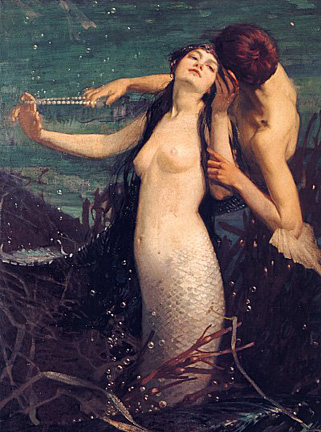
Pearls
for Kisses
Fred Appleyard
Perhaps we need to look at the mermaid story from a different perspective. In most stories of mermaids, a female is sighted, though there are a few reports of mermen. Whereas logic would say there should be as many reports of merman as there are of mermaids. In many mermaid stories we are told they come out of the sea and even marry fishermen. Which is a very clever trick for someone with a fish’s tail, except that in some reports a fish tail is not always mentioned. The ancient Greeks called mermaids ‘sea nymphs’ or ‘nereids’ and describe them as simply nude women who swam in the sea, similar to a reported sighing in the 19th century.
On September 8 1809 and school master in England wrote to “The Times” stating that twelve years previous he was on the shore of Sandside Bay when he saw a naked woman sitting on a rock. He then only concluded she was a mermaid because, he then realised that the rock she was sitting on was too dangerous for swimmers. She then dropped in the sea and swam away, and other people also witnessed the same incident.
The School Master clearly states at first, that what he saw was a naked women, he made no mention of a fish’s tail. It seems he only changed his mind when he realised that where she sat was dangerous for swimmers. Another question he may have asked himself was, what was a naked women doing swimming in the sea in 19th century Britain? Such behaviour may not be so unusual in the 21st century, but women in those times didn’t go in for athletic sports like swimming in dangerous waters, or parade themselves completely nude in public.
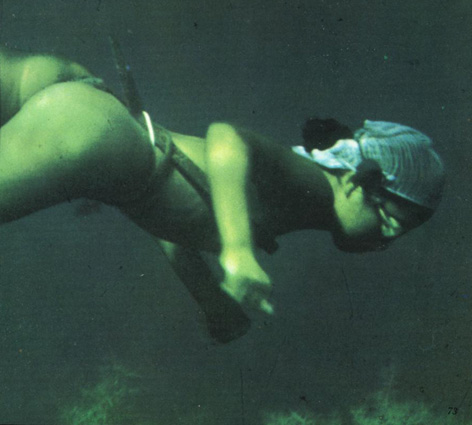
Reports of mermaids having legs are not that unusual. In Ireland old tales claim that the mermaids lived on dry land below the sea. (Which sounds like a very Irish story). In the Shetland islands they say that mermaids wear animal skins to swim in the water and then take them off to walk on land. (A early form of wet-suit?). These islanders also report that they themselves are descendants of mermaids. The Orkney Islanders claim that mermaids don’t have fish’s tails, but instead wear long petticoats that resemble a fish’s tail when they swim in the sea. There are also many reports of mermaids having two tails. Could they be two legs instead, ending in an early type of flipper? (In 1500 Leonardo da Vinci invented flippers for divers, so this is not a new idea).
The key to making sense of all these tales comes through the story of a Dutch seaman called Hamel. He was on a Dutch ship, ‘Sperwer’ that was wrecked near the Korean island of Cheju in 1653. Where he and the other survivors of the wreck spent ten months on the island. On returning to Holland, he wrote a book about his experiences and claimed that there were mermaids on the island. What’s interesting is that even today women from the island dive for shellfish and edible seaweed. Does this mean that what we refer to as mermaids are simply women divers?
There have been reports of women divers working of the coasts and islands of Japan going back 1500 years. They dive for shellfish, seaweed, starfish, octopuses and pearls and do this all year round, even in the winter were the water temperature is down to 50°F. They have been known to dive as deep as 30M and stay underwater for over 3 minutes. The food they gather, they place in a net around their waists and many keep on diving to up to 60 years of age or more. In the past they only dived in a loincloth but in more recent times they use modern flippers, face masks and snorkels. Scuba gear was banned by the authorities as they feared that the use of modern equipment would over fish the area. In Korea they allow wet suits but they are banned in Japan. There are a few male divers as well but women are able to work far longer in cold water than the average man.
In the 1960’s western journalists discovered these divers and topless photos of some of the more attractive women appeared in magazines and books. Yet it seems these women were not just half-naked bimbos, swimming in the warm shallow waters of a tropical sea. They are tough working women. A clue to how tough they are comes from the fact that both the Chinese and Japanese call mermaids, ‘dragon-wives’. The Cheju-do women are referred to by some Korean commentators as amazons, because they are far more assertive than ordinary Korean women. It seems that while the women are out diving, the men stay at home and look after the children and house. In the extremely “macho” society of Korea, these “tough” women and their “weak” husbands are an embarrassment. For this reason at one time no documents exist about the women divers in Korea, because historically records concerning them were forbidden.
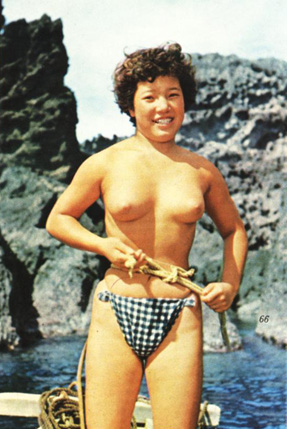 |
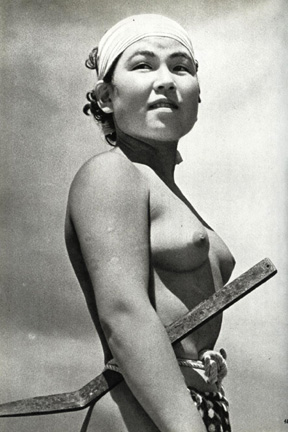 |
It suggests that because of the embarrassment of women doing a tough job better than they could, patriarchal institutions have kept silence about women divers. If this was true in Korea, could it also have been true in Europe and the Americas?
Now the waters around Japan and Korea are fairly cold but north of Japan in the Ussuri Territory, there was also once a local tradition of using professional women-divers. Even in these freezing waters women divers would continue diving even in the cold autumn months. Then in the 1920’s the Russian authorities began to use modern diving gear and motorboats equipped with dredges. Needless to say, when they adopted modern equipment the area in time became over fished until shell fishing was banned in 1960. Demonstrating the wisdom of the Korean and Japanese authorities in banning modern equipment for shell fishing.
According to the late Jacques Cousteau there was once women who dived completely naked for clams and crabs in Tierra del Fuego. These islands are at the most southern point of South America in waters of 42°F. So how is it that women divers were able to dive in very cold waters near the Arctic and Antarctic circles? Conditions that would kill a normal man within twenty minutes. It seems that women possess a higher percentage of subcutaneous fat all around their bodies that protect them from the cold in the water. In much the same way, marine animals like dolphins and seals have a layer of blubber to keep them warm. The fact that women can survive in these waters was proven by Lynne Cox. In 1987 this American women swam across the Bering Strait, from the U.S. to the Soviet Union with water temperatures down to 38°F. She achieved this without a wet-suit, wearing only a normal swim suit, cap and goggles.
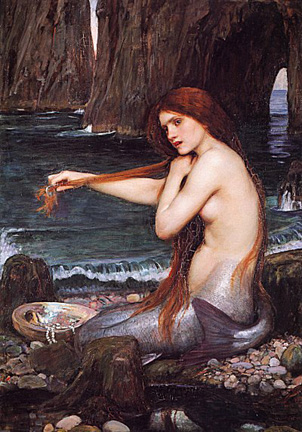
A
Mermaid
John William Waterhouse
In the sporting world we are used to men outperforming women, yet there is one sport where women now outperform men, the sport of marathon open water swimming. The first woman to swim 21 miles across the English Channel, was Gertrude Caroline Ederle of USA. In 1926 she broke the record held by the fastest man by one hour and fifty-nine minutes, in spite of having to battle through heavy seas in the second half of her swim. Since then the record for the fastest channel swim has been held at different times by both men and women. It seems that the longer the marathon swim, the easier it is for women to beat men.
Another sport where women can out-perform men is the very modern sport of “free-diving”, that is to say, diving without the use of air tanks. This sport has surprised scientists who have found that in deep dives the bodies of trained free-divers reacts exactly like that of a marine mammal. Where the human heart beat goes right down until it is barely beating. The water pressure crushes the lungs until they are the size of a drink can, without ill effects to the diver. Then what little oxygen is left in the body is used to keep the heart and brain just ticking over. This is exactly what happens to the bodies of whales and dolphins when they deep dive. This makes the human body more than capable of dealing with the problems of deep diving. As we can see from the following information.
On August 17, 2002- A new Freediving World Record was set by Tanya Streeter, at a depth of 160m/525ft in a total dive time of 3 minutes and 26 seconds. This dive shattered the previous women's No Limits World Record held by Canadian, Mandy-Rae Cruickshank (136m/446ft) and even surpasses the men's No Limits World Record of 154m/505ft held by Frenchman, Loic LeFerme.
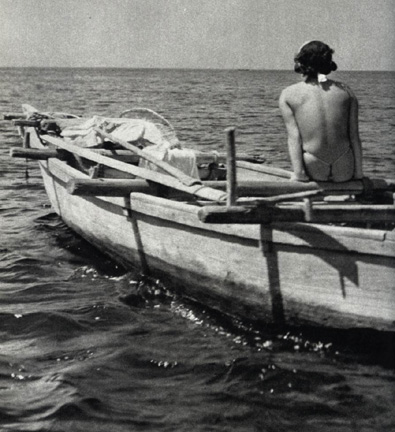
If we assume that mermaids are in fact women divers, then it means that the many sightings of mermaids indicate a past tradition of women divers throughout Europe, (as well as America before it was conquered by Europeans). What is more, judging by the sightings of mermaids, this tradition must have continued into the 19th century. However this leads us to another mystery. If this was the case, why do we not read about it in our history books? Why was it kept secret? We can get a clue to the reason from historical accounts dating back to Medieval times. Where there were bizarre stories of priests who encountering mermaids on the sea shore, would curse them as devils and threaten them with eternal damnation. The mermaids’ usual response was to burst into tears. These stories only sounds weird if we take the traditional view of a mermaid. If we assume that mermaids are women divers then it makes a lot of sense and gives an insight into the Christian Churches’ hostility to these working women. It seems that mermaids were associated with witches as being evil women and we know what the Christian Church did to witches. The infamous witch hunts of the Middle Ages completely wiped out the profession of women healers and herbalists, allowing this vocation to be taken over by male doctors. It must also be remembered that up until the 20th century women were discouraged from doing any work except the lowest paid menial jobs. Or work with no pay as a housewife. The experience from Japan and Korea shows that divers were well paid and this may be true of divers in Europe. Then the coming of anti-female religions like Judaism, Christianity, Islam and Confucianism brought about a change in attitude towards this ancient tradition. It is of interest that one of the foods banned by Judaism is shell-fish. Was this because it was women who traditionally harvest this food? Likewise in the 19th century pearl industry, western traders were horrified to learn that the locals used women pearl divers and even banned them in the Torres Strait islands.
Many mermaid stories are about a mermaid marries a fishermen and has children, but still has a yearning to return to the sea. In some tales she does do this and leaves both her husband and children behind. This resembles the plight of modern day women who try to juggle a job, husband and children at the same time. A woman working as a diver full time wouldn’t have the time or energy to look after a husband and children as well. So these mermaid stories may be about the dilemma faced by women divers concerning society’s rules that women should look after the home and children as her primary responsibility. Female wool spinners before the industrial revolution had the same problem. Spinning wool by hand was a high skilled job and women on average were far better at it than men. This gave these women a well paying job and the more highly skilled, even become very wealthy. So it is of interest that the word spinster comes from the word spinner. This indicates that even hundreds of years ago many women preferred the independence a well paying job like wool spinning, than becoming a wife and mother. Another point is that in some fairy stories, the wicked witch has a spinning wheel and use it to perform magic. So we find a connection of witchcraft to both spinners and divers.
What comes across is a form of discrimination against women similar to black people in the southern state of USA, after slavery was make illegal. Where successful or educated blacks were attacked and murdered by the Ku-Klu-Klan. Likewise successful women healers, herbalists, spinners and divers were probably threatened by witch hunters. The only reason wool spinners and divers escaped persecution was that they were unable to replace them with men.
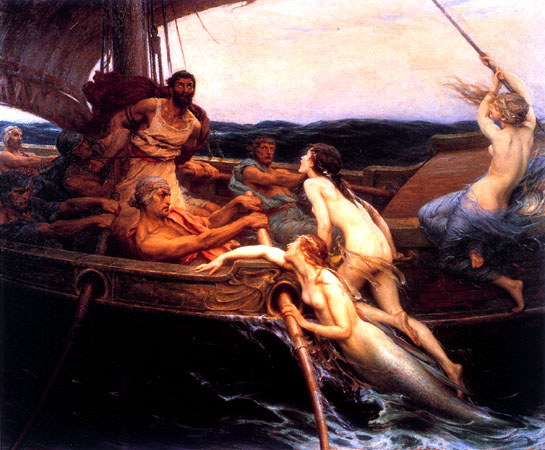
Ulysses
& the Sirens
Herbert Draper
It seems that women divers completely undermine patriarchal stereotypes of men and women. Up until the stirrings of feminism in the 20th century, women throughout the world were referred to as the “weaker sex”. Men claimed that they were not only bigger and stronger than women, but more intelligent and more capable doing everything better than women, (except of-course childbirth). Women divers were a big blow to men’s fragile egos because it was one job that women could do better than they could. It also seems that being able to out perform men, gave women a strong ego boost. Because throughout the world, women divers seem to have been very confident and assertive women. As mentioned before the Chinese and Japanese referred to mermaids as dragon wives while in Africa they were called river-witches. It seems the only reason why women divers survived in Korea into modern times is because they lived on remote islands and diving for food was vital for the islander’s survival.
The same thing must have happened in Europe. Male hostility would have discouraged the use of women divers, but in remote fishing villages along the coast, people living on the edge of starvation couldn’t afford to ignore an important food resource like shell fish and edible seaweed. So they continued this ancient tradition, in secret. The problem would be that outsiders, who are unaware of what is going on, would occasionally see the divers working. In an age when women were supposed to be physically weak, modest and submissive, these outsiders would be shocked to see, naked, athletic and assertive women confidently diving for marine food. It would be unlikely that the women would be clothed because wet clothing would be too much of a drag in water, and swimming costumes were not introduced until the Victorian times. Though reports from Shetland islands of mermaids wearing animal skins make sense providing they are from marine mammals. But the claim from the Orkney islands of mermaids wearing petticoats sounds incredible as not only would they give too much drag in the water but would be dangerous if caught in rocks, while underwater.
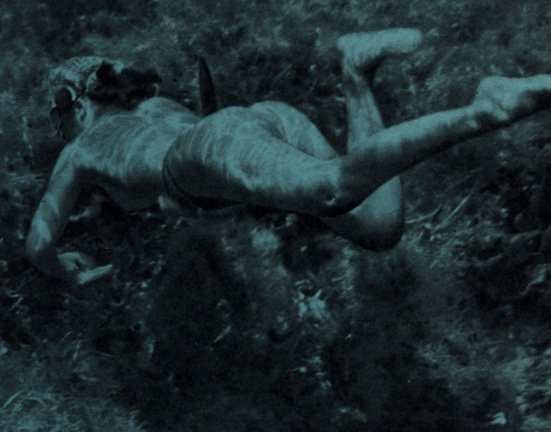
It means that it was sightings from outsiders that created the mermaid legend. Fishing villages that used women divers would greatly encourage this legend and embellish it even more, to divert attention away from the fact, it was village women who were the mermaids. Because they didn’t want their women to be accused of witch-craft. The Church may even have gone along with this, preferring to have stories of mythical mermaids rather than accounts of diving women who could a job better than men. So everyone involved had a reason to keep it secret.
This then is why mermaid stories are really a secret chapter of women’s history.
END
WILLIAM BOND |
SOURCES
“Mermaids, Nymphs Of The Sea” by Theodore Gachot
“The Diving Women Of Korea And Japan”, Scientific American. May 1967 Hermann Rahn and Su Ki Hong.
http://www.gmsys.net/prosjekt/csp/glimpses4.htm#Gentle divers of an ancient sea
http://members.cox.net/mermaid3.merhist.htm
http://rubens.anu.edu.au/student.projects/mermaids/folklores.html
http://www.orkneyjar.com/folklore/finfolk/mermaid.htm
http:www.mariner.0rg/exhibits/women/myths/mermaids.htm
http://www.hhp.ufl.edu/keepingfit/ARTICLE/femaleswim.htm
http://www.globaltechnoscan.com/18thApr-24thApr01/abyss.htm
http://www.apneamagazine.com/tanya_record-eng.html
www.ivin.narod.ru/scallops/fishing.htm
http://rubens.anu.edu.au/student.projects/mermaids/sightings.html
HOME
| UPDATES
| GALLERIES
| FOUNDER
| SHOP
| INTERACT
| JOIN
US! © 2004 - 2006 RASA VON WERDER
FEMALE EMPOWERMENT
| PURGATORY
| MYSTICAL
UNION | YOGA
CREATION, HEALTH, NATURE
& ANIMALS |
DREAMS
& VISIONS
MATRIARCHY
& THE FEMININE DIVINE | BEATIFIC
VISION
JESUS & MARY CHRISTIANITY